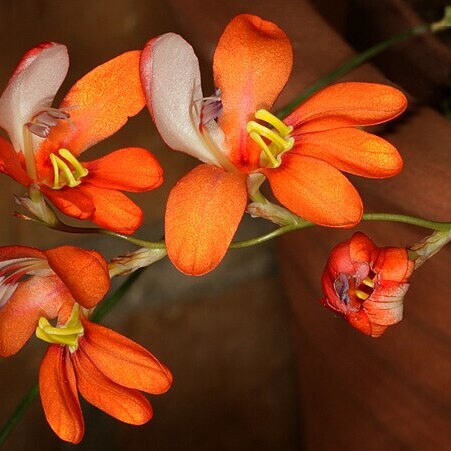Plants (100-)150-250(-350) mm high. Corm subglobose, 10-20 mm diam.; tunics of fine-textured or wiry fibres, sometimes thickened into flattened claws at base. Stem suberect or flexed outward above uppermost sheath, usually unbranched, rarely with 1 branch from near base. Leaves 4 to 8, linear-lanceolate to lanceolate, suberect or spreading in a 2-ranked fan, usually ± 1/2 as long as stem, (40-)80-200(-250) x (4-)6-10(-12) mm wide, acute to acuminate, main vein moderately thickened, margins slightly thickened, uppermost cauline leaf membranous, bract-like, sheathing, sometimes concealed by uppermost foliage leaf. Spike suberect, moderately lax, subsecund, 2-to 15-flowered; bracts dry-membranous, translucent flushed brown and speckled in upper half, 7-10(-12) mm long, minutely 3-or irregularly toothed, inner ± as long, shortly bifid. Flowers zygomorphic, orange or apricot-coloured with yellow throat and yellow spot on lower tepals surrounding callus; perianth tube obliquely funnel-shaped, (10-)12-15(-20) mm long, lower cylindric portion 3-6(-15) mm long, widening up to 6-8 mm diam.; tepals unequal, obovate, dorsal larger, slightly hooded over anthers, often paler inside, upper laterals spreading, lower tepals deflexed, upper tepals 10-15(-20) x 7-15 mm, lower (10-)12-15 x 5-8 mm, each with a quadrate yellow callus 2-4 mm high near base. Filaments unilateral, arcuate, 9-12(-15) mm long, exserted up to 6 mm; anthers (4-)5-6 mm long, often curved, violet. Style dividing opposite or beyond anthers, branches 4-6 mm long. Capsules ellipsoid, 7-10 mm long.
More
Perennial herb, geophyte, 0.15-0.30 m high; corm globose, tunics of fine fibres; stem simple or 1-branched. Leaves suberect or spreading, ensiform, 4-10 mm wide. Bracts papery, brownish towards apex. Inflorescence a ± secund spike; flowers reddish to orange, zygomorphic; perianth tube 12-20 mm long, funnel-shaped, with yellow throat; tepals unequal, 12-20 mm long, lower with large median, tooth-like, yellow callus. Stamens curved towards posticous tepals; anthers purple to mauve; pollen mauve. Style 17-25 mm long. Flowering time Aug., Sept. Capsule 7-10 mm long.
Cormous geophyte, 6-40 cm. Leaves sword-shaped to falcate, flat or twisted and undulate to crisped. Flowers bilabiate, scarlet-orange, occasionally yellow, lower tepals each with a large, tooth-like yellow callus.

